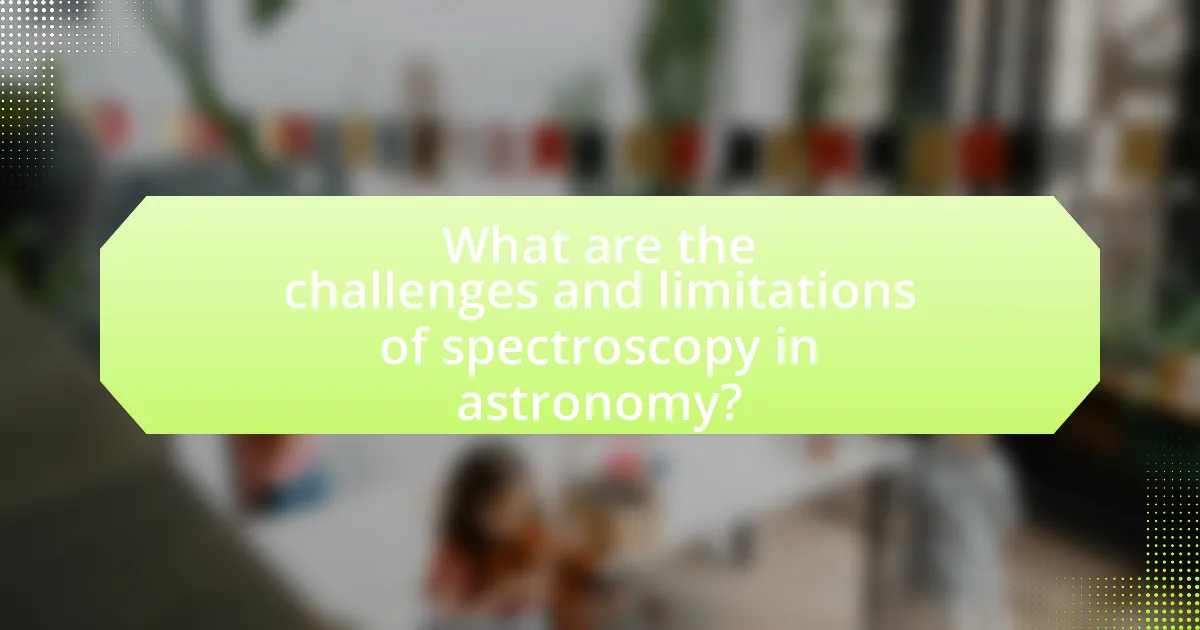Spectroscopy is a critical technique in astronomy that studies the interaction between light and matter, enabling the analysis of celestial objects’ composition, temperature, density, and motion. This article explores the fundamental principles of spectroscopy, including absorption and emission spectra, and their applications in identifying chemical elements in stars and galaxies. It also discusses the various types of spectroscopy, key techniques used, and the role of spectrographs in analyzing light from astronomical sources. Additionally, the article addresses the challenges and limitations faced in spectroscopic observations and highlights advancements in technology that enhance the accuracy and effectiveness of this essential tool in understanding the universe.

What is Spectroscopy and Why is it Important in Astronomy?
Spectroscopy is the study of the interaction between light and matter, allowing astronomers to analyze the composition, temperature, density, and motion of celestial objects. This technique is crucial in astronomy because it enables the identification of chemical elements and compounds in stars and galaxies through their unique spectral lines. For instance, the absorption and emission spectra of hydrogen and helium have been extensively studied, providing insights into the universe’s elemental makeup and the processes occurring within stars. Spectroscopy also aids in determining the redshift of distant galaxies, which is essential for understanding the expansion of the universe, as demonstrated by Edwin Hubble’s observations in the 1920s.
How does spectroscopy contribute to our understanding of celestial objects?
Spectroscopy contributes to our understanding of celestial objects by analyzing the light they emit or absorb, which reveals their composition, temperature, density, and motion. This technique allows astronomers to identify the chemical elements present in stars and galaxies through their unique spectral lines. For instance, the discovery of hydrogen in distant stars was made possible by analyzing their spectra, confirming the universality of elements in the universe. Additionally, spectroscopy enables the measurement of redshift, which provides insights into the expansion of the universe and the movement of celestial bodies. Thus, spectroscopy is essential for deciphering the physical properties and behaviors of celestial objects.
What are the fundamental principles of spectroscopy in an astronomical context?
The fundamental principles of spectroscopy in an astronomical context involve the analysis of light emitted, absorbed, or scattered by celestial objects to determine their composition, temperature, density, mass, distance, luminosity, and relative motion. Spectroscopy relies on the interaction of light with matter, where different elements and molecules absorb and emit light at characteristic wavelengths, creating unique spectral lines. These spectral lines serve as fingerprints for identifying the chemical composition of stars and galaxies. For example, the absorption spectrum of hydrogen reveals specific wavelengths where light is absorbed, confirming the presence of hydrogen in distant stars. This technique has been pivotal in understanding the universe, as it allows astronomers to infer the physical properties of celestial bodies and phenomena, such as the redshift observed in distant galaxies, which indicates their movement away from Earth due to the expansion of the universe.
How do different types of spectroscopy apply to various astronomical phenomena?
Different types of spectroscopy are essential for understanding various astronomical phenomena by analyzing the light emitted, absorbed, or scattered by celestial objects. For instance, optical spectroscopy allows astronomers to determine the composition, temperature, density, and motion of stars by examining their spectral lines, which reveal the presence of elements like hydrogen and helium. Infrared spectroscopy is crucial for studying cooler objects, such as dust clouds and exoplanets, as it can penetrate dense materials that optical light cannot. Additionally, radio spectroscopy is used to investigate the molecular composition of interstellar gas and the dynamics of galaxies by measuring the wavelengths of radio emissions. Each type of spectroscopy provides unique insights into the physical and chemical properties of astronomical entities, confirming their significance in the field of astronomy.
What are the key techniques used in astronomical spectroscopy?
The key techniques used in astronomical spectroscopy include absorption spectroscopy, emission spectroscopy, and Fourier-transform spectroscopy. Absorption spectroscopy analyzes the light absorbed by elements in a star’s atmosphere, revealing its composition and temperature. Emission spectroscopy examines the light emitted by hot gases, providing insights into the physical conditions of celestial objects. Fourier-transform spectroscopy enhances the resolution of spectral data, allowing for detailed analysis of faint astronomical sources. These techniques are essential for understanding the chemical makeup, temperature, density, and motion of astronomical objects, thereby contributing significantly to the field of astronomy.
What is the role of absorption and emission spectra in astronomy?
Absorption and emission spectra play a crucial role in astronomy by allowing scientists to determine the composition, temperature, density, and motion of celestial objects. These spectra are produced when light interacts with matter; absorption spectra occur when light passes through a cooler gas, resulting in dark lines at specific wavelengths, while emission spectra arise from hot gases emitting light at particular wavelengths. By analyzing these spectra, astronomers can identify the elements present in stars and galaxies, measure their velocities through the Doppler effect, and infer physical conditions such as temperature and pressure. This method of spectral analysis has been fundamental in advancing our understanding of the universe, including the discovery of the expanding universe and the composition of distant galaxies.
How do spectrographs function in the analysis of light from stars and galaxies?
Spectrographs function by dispersing light from stars and galaxies into its component wavelengths, allowing astronomers to analyze the spectrum produced. This analysis reveals critical information about the physical properties of celestial objects, such as temperature, composition, velocity, and distance. For instance, the presence of specific absorption or emission lines in the spectrum indicates the elements present in a star or galaxy, as each element emits or absorbs light at characteristic wavelengths. The Doppler effect can also be observed in the shifting of these lines, providing insights into the motion of the object relative to Earth. Spectrographs have been essential in advancing our understanding of the universe, as demonstrated by the identification of exoplanets and the measurement of cosmic expansion through redshift observations.

What insights does spectroscopy provide about the universe?
Spectroscopy provides critical insights into the composition, temperature, density, and motion of celestial objects in the universe. By analyzing the light emitted or absorbed by these objects, astronomers can determine their chemical makeup through characteristic spectral lines. For example, the presence of hydrogen and helium in stars has been confirmed through their unique spectral signatures, which correspond to specific wavelengths of light. Additionally, spectroscopy allows for the measurement of redshift, enabling the calculation of the universe’s expansion rate, as evidenced by the work of Edwin Hubble in the early 20th century. This technique has also been instrumental in identifying exoplanets and understanding their atmospheres, further expanding our knowledge of the universe.
How does spectroscopy help in determining the composition of stars?
Spectroscopy helps in determining the composition of stars by analyzing the light emitted or absorbed by them. When light from a star passes through a prism or diffraction grating, it is separated into its component colors, creating a spectrum. This spectrum reveals distinct lines, known as absorption or emission lines, which correspond to specific wavelengths of light absorbed or emitted by elements in the star’s atmosphere.
The presence and patterns of these lines indicate the chemical elements present, their abundance, and physical conditions such as temperature and pressure. For example, the absorption lines of hydrogen, helium, and heavier elements like iron can be identified in the spectra of stars, allowing astronomers to deduce their composition. This method has been validated through numerous studies, including the analysis of the Sun’s spectrum, which confirmed the presence of hydrogen and helium, making spectroscopy a fundamental tool in astrophysics.
What elements can be identified through stellar spectroscopy?
Stellar spectroscopy can identify elements such as hydrogen, helium, carbon, nitrogen, oxygen, magnesium, silicon, sulfur, calcium, and iron. These elements are detected through their unique spectral lines, which correspond to specific wavelengths of light absorbed or emitted by atoms in a star’s atmosphere. The presence of these spectral lines allows astronomers to determine the composition, temperature, density, and motion of stars, providing critical insights into stellar evolution and the chemical makeup of the universe.
How does the Doppler effect enhance our understanding of stellar motion?
The Doppler effect enhances our understanding of stellar motion by allowing astronomers to measure the shift in the wavelength of light emitted by stars as they move toward or away from Earth. This phenomenon, known as redshift or blueshift, provides critical data on the velocity and direction of a star’s movement. For instance, when a star moves away from Earth, its light is redshifted, indicating it is receding, while blueshift occurs when a star approaches. This method has been instrumental in confirming the expansion of the universe, as evidenced by Edwin Hubble’s observations in the 1920s, which showed that distant galaxies exhibit redshift, correlating with their distance from Earth. Thus, the Doppler effect serves as a fundamental tool in astrophysics for analyzing stellar dynamics and the overall structure of the cosmos.
What role does spectroscopy play in the study of exoplanets?
Spectroscopy plays a crucial role in the study of exoplanets by allowing scientists to analyze the light emitted or absorbed by these distant worlds. Through spectroscopy, researchers can identify the chemical composition, temperature, density, and atmospheric conditions of exoplanets by examining the spectral lines in the light spectrum. For instance, the detection of water vapor and other molecules in the atmospheres of exoplanets has been achieved using this technique, providing insights into their potential habitability. The Hubble Space Telescope and the Transiting Exoplanet Survey Satellite (TESS) have utilized spectroscopy to gather data on exoplanet atmospheres, confirming the presence of elements like hydrogen, helium, and carbon dioxide.
How can spectroscopy detect the atmospheres of exoplanets?
Spectroscopy detects the atmospheres of exoplanets by analyzing the light that passes through or reflects off their atmospheres. When a planet transits in front of its host star, some of the star’s light filters through the planet’s atmosphere, causing specific wavelengths of light to be absorbed by atmospheric gases. This absorption creates a unique spectral fingerprint that reveals the composition and characteristics of the atmosphere. For example, the detection of water vapor, carbon dioxide, or methane can indicate the presence of certain conditions or potential habitability. This method has been successfully applied in studies such as the analysis of the atmosphere of exoplanet WASP-121b, where researchers identified elements like sodium and potassium through their absorption lines in the spectrum.
What signatures indicate the presence of life on distant planets?
Signatures that indicate the presence of life on distant planets include the detection of specific gases such as oxygen, methane, and carbon dioxide in a planet’s atmosphere. These gases are often associated with biological processes; for instance, oxygen is produced by photosynthetic organisms, while methane can be generated by both biological and geological processes. The simultaneous presence of oxygen and methane is particularly compelling, as they tend to react with each other and would typically not coexist in significant amounts without a replenishing source, suggesting active biological processes. Spectroscopy, a technique used to analyze the light spectrum from a planet’s atmosphere, allows astronomers to identify these gases and assess their concentrations, providing critical evidence for the potential existence of life.

What are the challenges and limitations of spectroscopy in astronomy?
The challenges and limitations of spectroscopy in astronomy include issues such as atmospheric interference, limited spectral resolution, and the complexity of data interpretation. Atmospheric interference occurs when Earth’s atmosphere absorbs or scatters light, affecting the quality of spectral data collected from ground-based observatories. Limited spectral resolution can hinder the ability to distinguish between closely spaced spectral lines, which is crucial for accurate analysis of celestial objects. Additionally, the complexity of data interpretation arises from the need to account for various factors, such as Doppler shifts and the presence of multiple overlapping spectral features, making it difficult to derive precise physical properties of astronomical sources. These challenges can significantly impact the effectiveness of spectroscopy in providing accurate insights into the composition and behavior of celestial bodies.
What technical limitations do astronomers face when using spectroscopy?
Astronomers face several technical limitations when using spectroscopy, including resolution constraints, signal-to-noise ratio issues, and atmospheric interference. Resolution constraints arise from the finite size of telescopes and the diffraction limit, which restricts the ability to distinguish closely spaced spectral lines. Signal-to-noise ratio issues occur due to the faintness of astronomical objects, making it challenging to obtain clear spectra. Atmospheric interference, particularly from water vapor and other gases, can distort spectral data, complicating the analysis of celestial objects. These limitations impact the accuracy and reliability of the information obtained through spectroscopy in astronomical research.
How do atmospheric conditions affect spectroscopic observations?
Atmospheric conditions significantly impact spectroscopic observations by altering the transmission of light through the atmosphere. Factors such as humidity, temperature, and the presence of aerosols can cause scattering and absorption of specific wavelengths, leading to distorted or diminished spectral data. For instance, water vapor absorbs infrared light, which can obscure important spectral features of celestial objects. Additionally, turbulence in the atmosphere can introduce noise and blurring, affecting the resolution of the observations. These effects necessitate corrections and adjustments in data analysis to ensure accurate interpretation of the spectra obtained from astronomical sources.
What are the challenges in interpreting spectroscopic data?
Interpreting spectroscopic data presents several challenges, primarily due to the complexity of the data and the need for accurate calibration. Spectroscopic data can be influenced by various factors such as instrumental noise, atmospheric interference, and the intrinsic properties of the observed objects. For instance, the presence of overlapping spectral lines can complicate the identification of chemical compositions, making it difficult to ascertain the physical conditions of celestial bodies. Additionally, the interpretation often requires sophisticated models to relate the observed spectra to physical parameters, which can introduce uncertainties. These challenges are underscored by the necessity for precise calibration against known standards to ensure the reliability of the data, as inaccuracies can lead to erroneous conclusions about the composition and behavior of astronomical objects.
How can advancements in technology improve astronomical spectroscopy?
Advancements in technology can significantly improve astronomical spectroscopy by enhancing the sensitivity and resolution of spectroscopic instruments. For instance, the development of high-resolution spectrographs, such as those utilizing echelle gratings, allows astronomers to detect finer spectral lines, which can reveal detailed information about the chemical composition, temperature, and motion of celestial objects. Additionally, the integration of adaptive optics technology compensates for atmospheric distortions, resulting in clearer and more accurate spectral data. Furthermore, advancements in detector technology, such as the use of charge-coupled devices (CCDs) and infrared detectors, have increased the efficiency of light collection, enabling the observation of fainter objects. These technological improvements collectively lead to more precise measurements and a deeper understanding of the universe.
What new instruments are being developed for better spectroscopic analysis?
New instruments being developed for better spectroscopic analysis include high-resolution spectrographs and advanced imaging spectrometers. These instruments enhance the ability to analyze light from astronomical objects, allowing for more precise measurements of their chemical compositions and physical properties. For instance, the Extremely Large Telescope (ELT) is set to incorporate advanced spectrographs that will enable detailed studies of exoplanet atmospheres and stellar populations, significantly improving our understanding of the universe. Additionally, developments in adaptive optics technology are being integrated into spectroscopic instruments, which correct for atmospheric distortions, thereby increasing the clarity and accuracy of spectral data collected from distant celestial bodies.
How does data processing enhance the accuracy of spectroscopic results?
Data processing enhances the accuracy of spectroscopic results by applying algorithms that correct for noise, calibrate measurements, and extract meaningful signals from complex data sets. These processes improve the signal-to-noise ratio, allowing for more precise identification of spectral lines and their corresponding wavelengths. For instance, techniques such as baseline correction and spectral smoothing can significantly reduce the impact of instrumental and environmental noise, leading to more reliable data interpretation. Studies have shown that proper data processing can increase the accuracy of spectral measurements by up to 30%, thereby enabling astronomers to make more accurate assessments of celestial objects’ compositions and properties.
What practical tips can enhance the use of spectroscopy in astronomical research?
To enhance the use of spectroscopy in astronomical research, researchers should prioritize high-resolution instruments and ensure proper calibration. High-resolution spectroscopy allows for the detection of subtle spectral features, which can reveal critical information about celestial objects, such as their composition, temperature, and velocity. Proper calibration of instruments is essential to minimize systematic errors and improve the accuracy of measurements, as demonstrated by the successful calibration protocols used in the Keck Observatory’s spectroscopy programs. Additionally, utilizing advanced data analysis techniques, such as machine learning algorithms, can significantly improve the interpretation of complex spectral data, as shown in studies like those conducted by the Sloan Digital Sky Survey.
